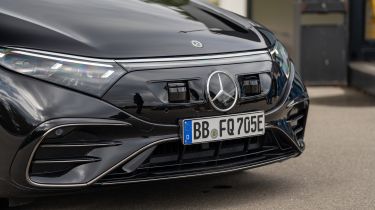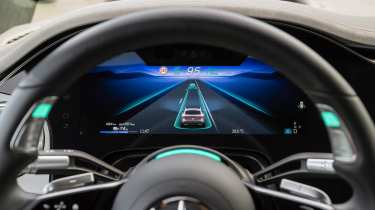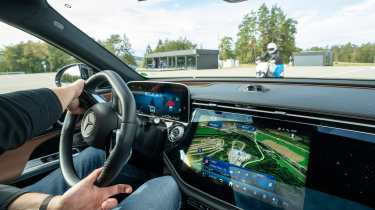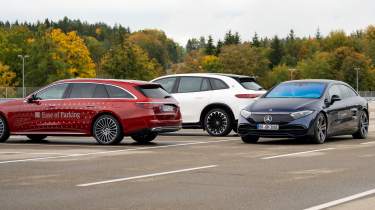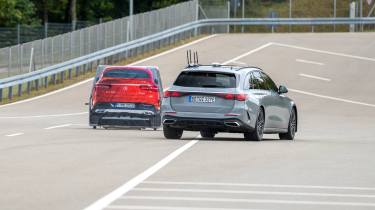Advanced Mercedes safety tech has 25 years to end all road accidents
Zero road accidents by 2050? We test latest Mercedes tech that’s intended to keep drivers out of trouble
The low autumn sun is streaming into your car as you drive along a dual carriageway in Europe at 30mph. You move into the slip lane ready to turn left across the oncoming traffic – and suddenly a motorcyclist’s white helmet looms large in your windscreen. Stunned, you brace for impact…
This scenario is playing out at Mercedes’ 200-million Euro (£166m) Immendingen test facility in Germany. We’re riding in the latest E 300 de equipped – like all new Mercedes cars – with Active Brake Assist. There’s a warning beep and a hiss of static as the car slams on the brakes sufficiently hard to dip the estate car’s diesel-packed nose and press your body against the pre-tightened seatbelt. But the retardation is momentary: just enough to allow the motorcycle safely past, but not too much to make a rear-end shunt from the following car inevitable.
Such is Active Brake Assist’s fiendishly complex choreography. A Mercedes car’s network of radars and cameras is permanently on alert, watching for errant pedestrians or vehicles while unsuspecting drivers adjust the sun visor or air-con. Meanwhile myriad lines of code calculate the car’s response, such as how hard and for how long to activate the brakes.
And that blast of pink noise on the stereo? To cause your ear muscles to contract, preventing temporary deafness potentially caused by the explosive airbag deployment. That way, the occupants can better hear the instructions of the emergency services, which the Mercedes will already have alerted with a distress signal.
There’s no angry wave of the motorcyclist’s fist: he’s a dummy propelled on hidden castors following the path of a guiding test car to which it’s wirelessly networked. The dummy biker and ‘mission control’ van orchestrating proceedings cost 300,000 Euros (£249,000) alone.
It’s just another day on Immendingen’s active safety test area, created specifically to assist the development of autonomous vehicle technology and Advanced Driver Assistance Systems (ADAS). And it’s critical work: in the past five years, 1,596 motorcyclists died on UK roads, according to statistics from the Department for Transport. Collisions between a car and a motorcycle were the most common cause of fatality, resulting in about one-third of that awful toll.
Active Brake Assist also helps to safeguard other vulnerable road users, such as pedal cyclists and pedestrians. Mercedes has delivered more than 10 million cars with its pedestrian anti-collision system in a little more than a decade.
We simulate other common accident scenarios, including the E 300 de pulling out of a junction in front of a fast approaching biker. The sensors show their versatility, picking up a hazard closing side-on this time, once more bringing the car to a timely halt.
Then there’s Evasive Steering Assist (ESA), a powerful tool for preventing those all-too-common rear-end collisions that cause whiplash and often gum up motorways. Our test driver, Jan Hoffmann, accelerates the E 300 de towards a parked Mercedes, the foam mock-up’s red rump growing closer and bigger. Again our digital guardian angels are watching, with the forward radar and camera monitoring the closing distance and assessing if adjacent lanes offer an escape route.
The warning systems chime and Jan whips the wheel right. His action triggers ESA, with the algorithm calculating the appropriate amount of power steering assistance to get us around the obstacle and then safely back into lane without overshooting. Another accident averted. And if Jan hadn’t taken action, we still had the safety net of the Active Brake Assist system to fall back on.
Testing Mercedes DrivePilot: watch videos while it drives at 59mph
While active braking became mandatory on all new cars sold in Europe from July 2024, Mercedes is blazing a trail with its Drive Pilot automated driving assistance. Soon, German drivers of high-spec Mercs will be able to take their eyes off the road and watch films or play video games while their car cruises the autobahn at up to 95kmh (59mph).
I jump into an S-Class alongside field test driver Els Hentschel, who is poised to demonstrate the latest Drive Pilot. It’s the world’s first higher-speed ‘Level 3’ driver-assistance system close to approval, permitting the car to drive itself under certain conditions: on autobahns or highways at up to 59mph, with the car keeping itself in lane and following the car in front.
We set off behind a GLS SUV and Els activates the system by pressing a silver button in the steering wheel rim. A lighting strip turns turquoise, which is Drive Pilot’s signature colour and will be mirrored externally by additional front and rear lamps in due course; two US states have already approved this upgrade to tell other road users when a Mercedes is self-driving. Tap ‘okay’ and the digital driver’s display connects graphical representations of the S-Class and the vehicle it’s following – and Hentschel can relax.
Equipment in addition to Brake Assist includes a LiDAR, which fires laser light down the road and determines how far obstacles are away by measuring the time it takes for the reflected light to return to the receiver. There are more cameras (one rearwards) and a weather sensor – Drive Pilot can’t yet be activated in the rain in case it compromises the sensor network. All of this is woven together by advanced software making judgement calls on the environment.
Up ahead there’s a Mercedes stranded on the hard shoulder so the S 580 glides sideways to create space in case someone opens a door: it’s more aware and considerate than some drivers. Then an EQS suddenly cuts into our lane: it takes me by surprise but not the Mercedes, which automatically drops anchor. “There’s no need for steering but the car would have done so if necessary,” assures Hentschel. The final demonstration is when our leading GLS starts reversing towards the S 580 – and just before the crunch of bumpers, the S-Class instinctively sounds its horn.
Hentschel also demonstrates what happens if the leading car changes lanes or pulls away: a gentle bonging sound, red lighting and a warning text exhort the driver to retake control. Ten seconds later the seatbelt starts tugging the driver and if there’s still no response, Drive Pilot will safely bring the car to a halt, activate the hazard warning lights and send a distress signal to Mercedes’ call centre.
This is the second iteration of Drive Pilot, with the first restricted to 60kmh (39mph). That was useful only in stop/start congestion, whereas the upgraded system can now follow lorries in the slow lane while you finish that email. Plenty will find that speed too slow: Mercedes predicts it could take until the end of the decade to finesse the system to manage 130kmh (80mph).
Drive Pilot costs almost 6,000 Euros in Germany, but existing S-Class and EQS cars featuring the hardware will be upgraded for free at the next service or over the air. The 95kmh (59mph) version will roll out from January 2025, once the German regulator has signed it off – and that means vigilant owners should not be liable for any accidents.
UK legislation has paved the way for the system to be individually approved by the Vehicle Certification Agency, but it all depends on whether Mercedes can build a business case to roll it out. Costs would include having to map all 2,300 miles of the country’s motorway network – in each lane. This HD mapping and a highly accurate antenna enables Drive Pilot to position the car to within a couple of centimetres, to
help keep a Mercedes in lane. Indeed, the system is so sensitive it can even detect the earth’s shifting tectonic plates.
“We won’t do any beta testing with our customers,” says autonomous driving spokesperson Alexandros Mitropoulos in a
swipe at Tesla’s Autopilot system. That remains at Level 2 ‘partial automation’ despite billions of customer test miles and Elon Musk’s predictions. “If a Mercedes-Benz customer can buy it, they can be sure it’s pretty safe,” he claims.
Mercedes’ boss on eliminating road accidents by 2050
Mercedes is on a mission to improve road safety: it has committed to Vision Zero, a quest to eliminate accidents entirely by 2050.
“We would like to live in a world with no accidents and certainly no fatalities,” Mercedes-Benz chairman Ola Källenius tells Auto Express at the Immendingen proving ground. “Everybody talks about Euro NCAP [crash testing] and its five stars, but internally we say one star is usually enough – the Mercedes star. We have a testing regime that is more comprehensive than some rating institutes because it’s about real-life safety.”
The company sends a team to investigate every major accident in a current model within 120 miles of the safety HQ. Then, there’s the brand’s long history of safety, with early innovations such as crumple zones, decoupling steering columns and door locks that could still be opened after an impact.
In 1978, Mercedes introduced ABS anti-lock brakes on the S-Class, the model which co-introduced ESP electronic stability control in 1995. By braking individual wheels and throttling engine torque if sensors predicted an imminent loss of control, vehicles could be prevented from leaving the road or rolling over.
“The logic 25 years ago was that new technology came in the S-Class, then you democratised it through your line-up, then maybe everybody else in the auto industry got it as well. That logic has been a bit upended in the past 10 years or so, where we have said innovation could come in any model.
“So if we launch automated driving in the CLA that comes next year, it will be the most sophisticated system we’ve ever done. Any new generation of Mercedes is the safest we’ve ever made because technology never stops.”
That will be on top of the systems we’ve tested today. No wonder the company predicts it will halve the number of people killed and seriously injured in accidents involving a Mercedes this decade. And that will be a welcome contribution to the quest to reduce life-changing accidents around the world.
A guided tour of Mercedes’ incredible Immendingen proving ground
Where can you drive up ramps so steep an asphalt covering would slip off, mountainous hairpins climbing 180 metres, then a motorway that crosses from France to China? At Mercedes’ Immendingen proving ground, opened in 2018.
Mercedes converted a former military site just over an hour’s drive south of Stuttgart into a 520-hectare base for car testing. Off-roading, a high-speed bowl, hot and cold weather chambers, and wet and dry handling circuits are among the site’s extensive test facilities. And the road markings, signage and conditions simulate roads from all over the globe.
Up to 400 prototypes can test at any one time, all fitted with devices relaying their locations and speeds via Mercedes’ private LTE network. There’s a huge autonomous driving test pad where the engineers mock up traffic scenarios and even deploy mobile rain and snow machines to test sensors in harsh weather. Test water is stored in tanks the size of 36,000 bath tubs.
Mercedes has constructed a city centre, complete with 500-car parking garage, to assess its vehicles on urban streets. All watched over by sheep to mow the grass, llamas to protect them from foxes, skylark nesting areas and wildlife corridors to allow animals (including a roaming bobcat) to pass safely. It’s the ultimate, eco-sensitive playground to shape future Mercedes.
Want the latest car news in your inbox? Sign up to the free Auto Express email newsletter...
Find a car with the experts

